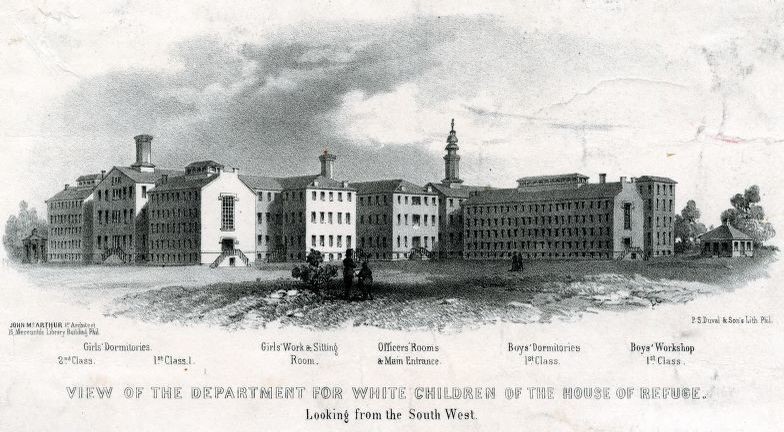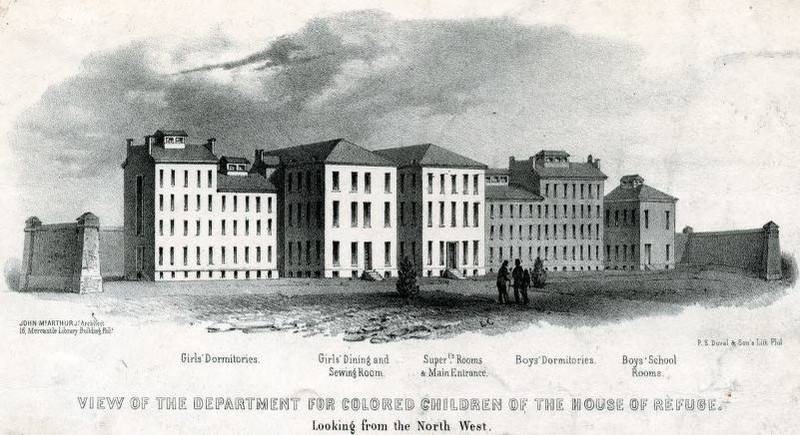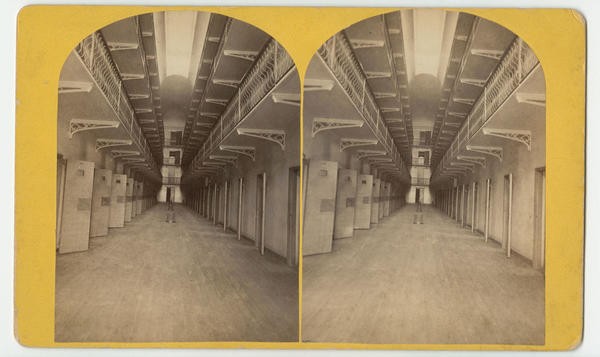Philadelphia House of Refuge (Fairmount, 1850-1892)
Introduction
Text-to-speech Audio
The Philadelphia House of Refuge served as a reformatory prison alternative for juvenile delinquents in Philadelphia’s Fairmount neighborhood from 1850 to 1892. Originally established in 1828 in the Spring Garden section of the city, the House of Refuge was a part of the early 19th century incarceration reform movement. Its comprehensive plan of study was based on education, vocational training, and spirituality for boys and girls in a facility separate from the adult incarcerated population. The House of Refuge continued operations through the 20th century as the Glen Mills Schools, which ceased operation in 2019.
Images
View of the Department for White Children of the House of Refuge, illustration c. 1850 (Library of Congress)

View of the Department for Colored Children of the House of Refuge, illustration c. 1850 (Library of Congress)

Views of the House of Refuge, stereograph c.1858 (Library Company of Philadelphia)
.jpg)
Views of the House of Refuge, stereograph c.1858 (Library Company of Philadelphia)

Backstory and Context
Text-to-speech Audio
The Philadelphia House of Refuge, a prison alternative for juvenile delinquents and vagrants, was established in 1828 in Philadelphia’s Spring Garden neighborhood. It operated at the current-day intersection of Fairmount Avenue and 15th Street until it relocated to Fairmount in 1850. From then until 1892, the House of Refuge operated out of Fairmount. Though now demolished, it once stood on the space bounded by Twenty-second, Twenty-fourth, Parrish, and Poplar Streets.
The 19th century House of Refuge movement, which gave rise to the Philadelphia House of Refuge, was based on Quaker principles of moralistic reeducation. The movement’s philosophy focused on reforming the moral character and behaviors of juvenile offenders, rather than punishing them, in separate facilities from the incarcerated adult population. Established in 1828, Philadelphia’s House of Refuge followed the model of New York City’s House of Refuge (1825) and Boston’s House of Reformation (1826).
In Philadelphia specifically, the criminal youth population had grown dramatically in the late-18th early-19th century. In 1826, a solution was proposed to the city of Philadelphia through a collaboration between the Society of Women Friends and the Philadelphia Society for Alleviating the Miseries of Public Prisons, which, under the name Pennsylvania Prison Society, also established Eastern State Penitentiary a few blocks southward in 1829. The February 1826 resolution which ordered the organization of the House of Refuge concluded, according to contemporary newspaper American Daily Advertiser, that “experience has shown that much benefit has resulted to individuals and to society from establishments devoted to the safekeeping and moral improvement of the juvenile offenders” (Teeters, 168).
At its opening in 1828, the Philadelphia House of Refuge initiated a comprehensive curriculum of physical and vocational training for all children. The children’s daily schedules are reported to have been fully scheduled with a few hours of academic instruction consisting of the mathematics and humanities of the day accompanying a six to eight hours of labor in an apprenticed profession.
At its initial founding in 1828, the House of Refuge exclusively accepted white juveniles. Proposals for a segregated expansion to the original institution to support the inclusion of African American children appeared before 1830, but took decades to come to fruition. An integrated facility was out of the question, but the idea of a fully segregated House of Refuge for Colored Children gained support within the institution and among the local population.
When the institution relocated to Fairmount in 1850, the House of Refuge for Colored Children was established on the campus’s western side along Twenty-Fourth Street. It maintained a similar curriculum to the white building, however, a 1841 report from an internal committee—which included founders of the House of Refuge—to the Board of Managers in support of this new facility’s creation presents a different perspective on this addition than the inclusionary petitions may present. “Their opportunities for improvement in morals or useful learning of any kind, we know to be extremely limited,” the 1841 report said of these children, “These circumstances do not at all weaken our obligation…which lies upon us to provide for their improvement [and] for correcting the evils to which we are exposed by reason of their ignorance and vicious habits” (Packard, 5).
The House of Refuge did not ultimately live up to the goals of incarceration reformers. The Pennsylvania House of Representatives investigated the House of Refuge in 1876 for a variety of reported abuses, including the punishment of children via solitary confinement and malnourishment. In 1892 citing a need to expand, it relocated to Delaware County outside of Philadelphia and in 1911, was renamed the Glen Mills Schools. The institution was shuttered on April 8, 2019 by the Pennsylvania Department of Human Services.
Cite This Entry
Michael Griffith on behalf of Girard College and Katherine Haas. "Philadelphia House of Refuge (Fairmount, 1850-1892)." Clio: Your Guide to History. May 5, 2023. Accessed March 29, 2025. https://theclio.com/entry/147471
Sources
Cooper, Kenny. “Glen Mills Schools wants to reopen with a new name following decades of abuse allegations.” WHYY. Nov. 11, 2021. Accessed March 17, 2022. https://whyy.org/articles/glen-mills-schools-rename-child-abuse-clock-tower/.
Gartner, Lisa. “Pennsylvania closes the Glen Mills Schools amid child-abuse investigation.” The Philadelphia Inquirer. April 8, 2019. Accessed March 17, 2022. https://www.inquirer.com/news/glen-mills-schools-license-closed-pa-abuse-investigation-dhs-20190408.html.
Kopaczewski, James. “House of Refuge.” Encyclopedia of Greater Philadelphia.2016. Accessed March 17, 2022. https://philadelphiaencyclopedia.org/archive/house-of-refuge/.
Michel, Lauren. “Pennsylvania Prison Society.” Encyclopedia of Greater Philadelphia. Accessed March 17, 2022. https://philadelphiaencyclopedia.org/archive/pennsylvania-prison-society/#:~:text=Founded%20in%201787%20as%20the,salutary%20treatment%20of%20the%20incarcerated.
Packard, Frederick A, and African American Pamphlet Collection. Report on the practicability and necessity of a house of refuge for coloured juvenile delinquents in Philadelphia. Philadelphia: Brown, Bicking & Guilbert, Printers, 1841. Retrieved from the Library of Congress, www.loc.gov/item/92838004/.
Teeters, N. K. “The Early Days of the Philadelphia House of Refuge.” Pennsylvania History, vol. 27, no. 2 (April 1960): 165-187. Retrieved from Penn State University Libraries, https://journals.psu.edu/phj/article/view/22729.
View of the Department for White Children of the House of Refuge. Philadelphia: P.S. Duval & Son Lithography. Photograph. Retrieved from the Library of Congress, https://hdl.loc.gov/loc.wdl/wdl.9518.
View of the Department for Colored Children of the House of Refuge. Philadelphia: P.S. Duval & Son Lithography. Photograph. Retrieved from the Library of Congress, https://hdl.loc.gov/loc.wdl/wdl.9519
Chillman, P. E. Views of the House of Refuge, Philadelphia. Philadelphia. Photograph. Retrieved from the Library Company of Philadelphia. https://digital.librarycompany.org/islandora/object/digitool%3A100118.
Chillman, P. E. Views of the House of Refuge, Philadelphia. Philadelphia. Photograph. Retrieved from the Library Company of Philadelphia.

